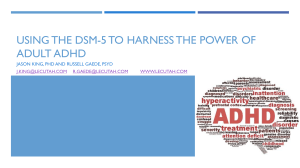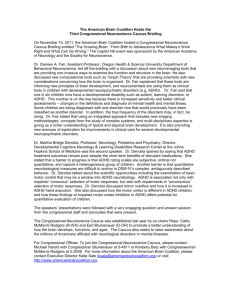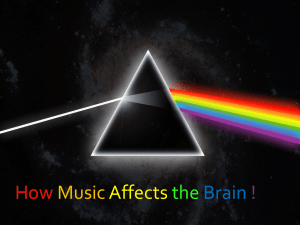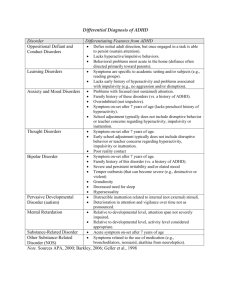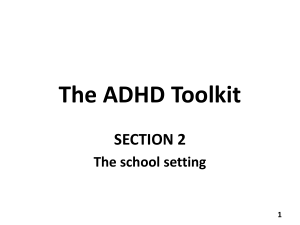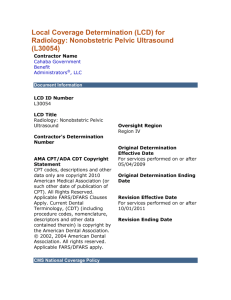ADHD algorithm
advertisement
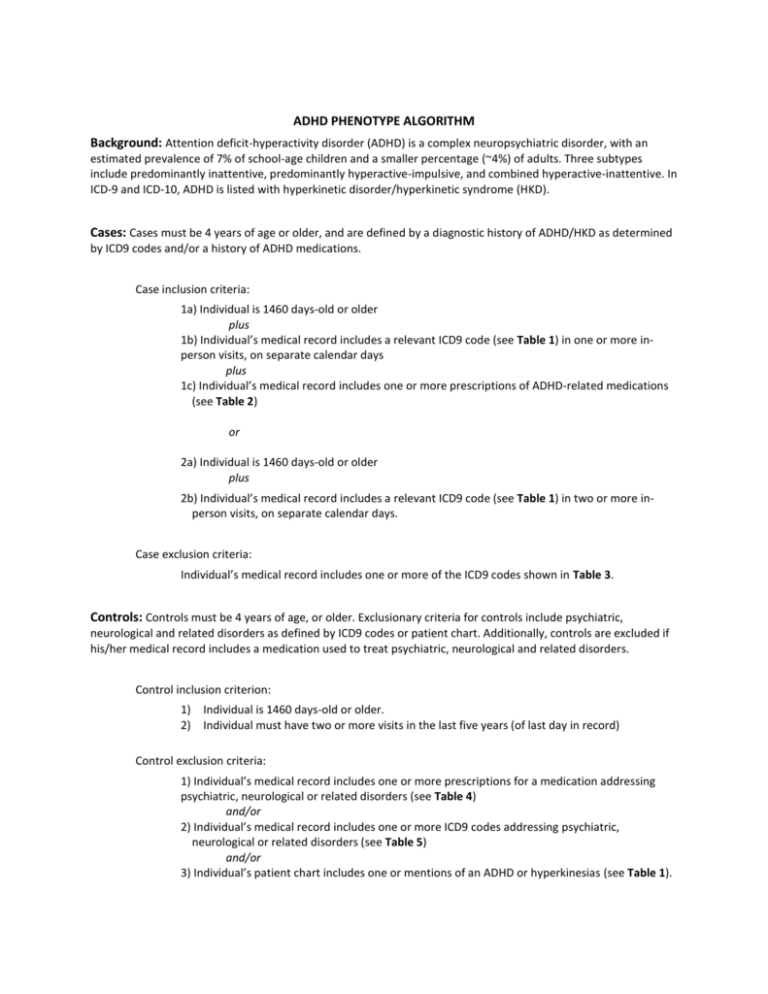
ADHD PHENOTYPE ALGORITHM Background: Attention deficit-hyperactivity disorder (ADHD) is a complex neuropsychiatric disorder, with an estimated prevalence of 7% of school-age children and a smaller percentage (~4%) of adults. Three subtypes include predominantly inattentive, predominantly hyperactive-impulsive, and combined hyperactive-inattentive. In ICD-9 and ICD-10, ADHD is listed with hyperkinetic disorder/hyperkinetic syndrome (HKD). Cases: Cases must be 4 years of age or older, and are defined by a diagnostic history of ADHD/HKD as determined by ICD9 codes and/or a history of ADHD medications. Case inclusion criteria: 1a) Individual is 1460 days-old or older plus 1b) Individual’s medical record includes a relevant ICD9 code (see Table 1) in one or more inperson visits, on separate calendar days plus 1c) Individual’s medical record includes one or more prescriptions of ADHD-related medications (see Table 2) or 2a) Individual is 1460 days-old or older plus 2b) Individual’s medical record includes a relevant ICD9 code (see Table 1) in two or more inperson visits, on separate calendar days. Case exclusion criteria: Individual’s medical record includes one or more of the ICD9 codes shown in Table 3. Controls: Controls must be 4 years of age, or older. Exclusionary criteria for controls include psychiatric, neurological and related disorders as defined by ICD9 codes or patient chart. Additionally, controls are excluded if his/her medical record includes a medication used to treat psychiatric, neurological and related disorders. Control inclusion criterion: 1) Individual is 1460 days-old or older. 2) Individual must have two or more visits in the last five years (of last day in record) Control exclusion criteria: 1) Individual’s medical record includes one or more prescriptions for a medication addressing psychiatric, neurological or related disorders (see Table 4) and/or 2) Individual’s medical record includes one or more ICD9 codes addressing psychiatric, neurological or related disorders (see Table 5) and/or 3) Individual’s patient chart includes one or mentions of an ADHD or hyperkinesias (see Table 1). Covariates: Relevant covariates are: 1) age, 2) gender, 3) ethnicity, race, and 4) birth month (younger children can be more hyperactive in the classroom, which may be mis-diagnosed as ADHD) Ref: Elder Todd. The Importance of Relative standards in ADHD Diagnoses: Evidence Based on Exact Birth Dates. J. Health Economy. Sept 2010;29(5):641-656). Table 1, ADHD Cases: Inclusionary ICD Codes ICD-9 Code Diagnosis 314 Hyperkinetic syndrome of childhood 314.0 Attention deficit disorder 314.01 With hyperactivity 314.1 Hyperkinesis with developmental delay, Developmental disorder of hyperkinesis 314.2 Hyperkinetic conduct disorder 314.8 Other specified manifestations of hyperkinetic syndrome 314.9 Unspecified hyperkinetic syndrome Table 2, ADHD Cases: Inclusionary medications by sub-type. Stimulants Non-Stimulants Other Drugs Norepinephrine reuptake Methylphenidate NDRI inhibitor Attenta NRI Amfebutamone Concerta Atomoxetine Aplenzin Daytrana Attentin Buproprion Desoxyn Strattera Elontril Hynidate Tomoxetin Prexaton Metadate Voxra Methylin Wellbutrin Methyllin Alpha-2 Agonists Zyban Rilatine Clonidine SNRI's (Tricyclics) Ritalin Guanfacine Imipramine Dexmethylphenidate Melipramine Attenade Tofranil Celgene Carbamazepine Focalin Equetro Amphetamine Tegretol Adderall Clonazepam Dexedrine Clonex DextroStat Klonopin Prodrug Amphetamines Kriadex Lisdexamfetamine Linotril (Vyvanse) Paxam Petril Ravotril Rivatril Rivotril Divalproex Depakote Epilim Other Drugs Imipramine Melipramine Tofranil Lithium Eskalith Lithobid Olanzapine Zyprexa Paroxetine Aropax Brisdelle Paxil Pexeva Sereupin Seroxat Pemoline Betanamin Ceractiv Cylert Tradon Risperidone Risperdal Sertraline Altruline Besitran Daxid Deprax Eleval Emergen Fluoxetine Fontex Prozac Sarafem Hydroxyzine Alamon Atarax Aterax Durrax Equipose Orgatrax Masmoran Paxistil Quiess Tran-Q Tranquizine Vistaril Gladem Implicane Lowfin Lustral Sealdin Sedoran Serivo Sertralin Stimuloton Tresleen Zoloft Trazodone Beneficat Deprax Desirel Desyrel Mesyrel Molipaxin Oleptro Thombran Trazorel Trialodine Trittico Table 3, ADHD Cases: Exclusionary ICD9 Codes. Psychiatric and Related ICD-9 Codes Diagnosis 290 Dementias 294 Persistent mental disorders due to conditions classified elsewhere300.8x Somatoform disorders 301.51 Chronic factitious illness with physical symptoms 307.3x Stereotypic movement disorder 317-317.x Mild mental retardation 318-318.x Other specified mental retardation 319-319.x Unspecified mental retardation General ICD-9 Codes Diagnosis 006.5 Amebic brain abscess 013.2 Tuberculoma of brain 191-191.x Malignant neoplasm of brain 192-192.x Malignant neoplasm of other and unspecified parts of nervous system 237.7x Neurofibromatosis 290.1 Presenile dementia 348.1 Anoxic brain damage 348.2 Benign intracranial hypertension 348.3 Encephalopathy, not elsewhere classified 348.4 Compression of brain 348.5 348.8 348.9 437.2 742-742.x 764-764.x 767.0 767.9 800-804 959.01 Cerebral edema Other conditions of brain Unspecified condition of brain Hypertensive encephalopathy Other congenital anomalies of nervous system Slow fetal growth and fetal malnutrition Subdural and cerebral hemorrhage Birth trauma, unspecified Fracture of skull Head injury, unspecified Table 4, ADHD Controls: Exclusionary medications by sub-type. Stimulants Non-Stimulants Other Drugs Norepinephrine reuptake Methylphenidate SNRI's (Tricyclics) inhibitor Attenta NRI Imipramine Concerta Atomoxetine Melipramine Daytrana Attentin Tofranil Desoxyn Strattera Carbamazepine Hynidate Tomoxetin Equetro Metadate Tegretol Methylin Clonazepam Methyllin Clonex Rilatine Klonopin Ritalin Kriadex Dexmethylphenidate Linotril Attenade Paxam Celgene Petril Focalin Ravotril Amphetamine Rivatril Adderall Rivotril Dexedrine Divalproex DextroStat Depakote Prodrug Amphetamines Epilim Lisdexamfetamine Fluoxetine (Vyvanse) Fontex Prozac Sarafem Hydroxyzine Alamon Atarax Aterax Durrax Equipose Orgatrax Masmoran Paxistil Quiess Other Drugs Imipramine Melipramine Tofranil Lithium Eskalith Lithobid Olanzapine Zyprexa Paroxetine Aropax Brisdelle Paxil Pexeva Sereupin Seroxat Pemoline Betanamin Ceractiv Cylert Tradon Risperidone Risperdal Sertraline Altruline Besitran Daxid Deprax Eleval Emergen Gladem Implicane Lowfin Lustral Sealdin Tran-Q Tranquizine Vistaril Sedoran Serivo Sertralin Stimuloton Tresleen Zoloft Trazodone Beneficat Deprax Desirel Desyrel Mesyrel Molipaxin Oleptro Thombran Trazorel Trialodine Trittico Table 5, ADHD Control Exclusionary ICD9 Codes. ICD-9 Codes Diagnosis 006.5 Amebic brain abscess 013.2 Tuberculoma of brain 191-191.x Malignant neoplasm of brain 192-192.x Malignant neoplasm of other and unspecified parts of nervous system 237.7x Neurofibromatosis 290-319.x Mental disorders 327-327.x Organic sleep disorders 330-337.x Hereditary and degenerative diseases of the central nervous system 342-342.x Hemiplegia and hemiparesis 343-343.x Infantile cerebral palsy 344-344.x Other paralytic syndromes 345-345.x Epilepsy and recurrent seizures 347-347.x Cataplexy and narcolepsy 348-348.x Other conditions of brain 349-349.x Other and unspecified disorders of the nervous system 437.2 Hypertensive encephalopathy 742-742.x Other congenital anomalies of nervous system 758.x Chromosomal anomalies 764-764.x Slow fetal growth and fetal malnutrition 765-765.x Disorders relating to short gestation and low birthweight 767.0 Subdural and cerebral hemorrhage 767.9 Birth trauma, unspecified 779.4 Drug reactions and intoxications specific to newborn 779.5 Drug withdrawal syndrome in newborn 781-781.x Symptoms involving nervous and musculoskeletal systems 800-804 Fracture of skull 959.01 Head injury, unspecified 996.2 Mechanical complication of nervous system device, implant, and graft

